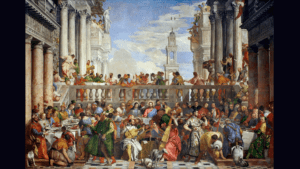In less than a week, our missionaries will be out on the streets of New York during Holy Week for the first time since 2019. Our theme this year will be Compassion, as evidenced by the Father in the Return of the Prodigal Son. Sign up to be a missionary.
I recently wrote a short reflection on the Prodigal Son and Rembrandt’s famous rendition of the parable; all our missionaries will be pinned with a “Prodigal Son” button before heading out…
Rembrandt Comes Home *


The parable of the prodigal son is one of the stories everyone remembers from the Bible. It’s in Luke 15. “There was a man who had two sons,” Jesus begins, “and the younger of them said to his father, ‘Father, give me the share of property that falls to me.’ And he divided his living between them” (vv. 11–12).
Of course, the younger son goes off and spends everything on wild parties. Finally, when he’s homeless and starving, he decides to go back and beg his father to take him in as a hired worker because at least his father’s workmen have food and a roof over their heads. “Father, I have sinned against heaven and before you; I am no longer worthy to be called your son” (v. 21).
But the father is so delighted to have his son back that he throws a big party to welcome him back into the family. “Let us eat and make merry; for this, my son was dead, and is alive again; he was lost, and is found” (vv. 23–24).
In this painting, Rembrandt shows us that dramatic moment when the father suddenly embraces his begging son. But I think there’s another story here, too.
Like Caravaggio’s Denial of Saint Peter, which we stopped at earlier, this “last painting” may be a cry across time from an artist who was searching for God but — like many of us — may have taken a wrong turn. And now, near the end, he was regretting it.
The emotive emotional power of this work is, in many art historians’ minds, unmatched in the history of art. In the forefront of the canvas kneels the younger son, who has wasted his father’s estate in a life of promiscuity and dissipation and has now crawled home, almost shoeless, contrite. He has committed virtually the entire list of mortal sins in Jewish law, the “whole left side of the menu.” In the process, he has wasted all the funds he had taken from his father on things of the secular world. Instead of buying him happiness, it has bought him misery. Now he returns with nothing to offer but a contrite heart. He kneels in humility and prayer before the father. He’s hoping against hope for a job in the fields. He believes he is unforgivable.
Standing above him — no, crouching with him — Rembrandt places the father. Surprisingly, perhaps, the father not only forgives the prodigal but also embraces him warmly. He restores him to his place in the household. He gives him back his dignity, the dignity that the son believes has long been lost. Now, a joyful, welcoming light flows out of the father himself, enveloping the son, bringing him home out of the darkness. It is “the light that comes from an inner fire that never dies: the fire of love.”[1]
My eye is drawn to those two hands of the father. Art historians have long debated Rembrandt’s “mistake” here. The father’s two hands are different: his left hand strong and masculine, his right hand slender and feminine.
Some believe this is Rembrandt’s reference to the two hands of God: justice for sure, but also mercy, which prevails here in the loving way the father’s arms — indeed, his entire body — embrace the prodigal son.
In this last testament, Rembrandt is both seeking forgiveness and hoping for mercy. The great artist has been brought to his knees. He’s seeking the forgiveness of the Father, pleading with him over time and space for mercy, not justice. For love, not disdain. Forgiveness, not revenge.
There’s more, as usual. Who is that mysterious figure standing to the right? It’s the older son! Well dressed in the fine clothes and jewels that led to his younger brother’s ruin, he stands apart, looking on diffidently “with clasped hands”[2] as this scene of mercy and forgiveness unfolds. Though technically still a part of the overall composition, he seems strangely distant, aloof. He has stayed at his father’s side loyally and obediently all these years while the prodigal was out partying away the estate. What a contrast here to the forgiving attitude of the father! While the father is warm and generous in his love, the older son seems judgmental, condemning, and maybe even jealous that at this late hour, the younger son is being forgiven. If he were running things, which he hopes he’ll soon be, this miscreant would never have been allowed back on the estate!
What’s wrong here? The older brother has followed all the rules. But the father is not embracing him. He’s embracing the prodigal. And later, when the celebratory party begins, the older brother won’t even be part of it.
For all his loyalty, the older son fails one simple test. He doesn’t let the father love him. He’s too proud for that. He won’t drop to his knees to ask the old man for love, for mercy. And as a result, he can’t love him back. And he certainly can’t love his brother.
And just as we settle in here, coolly evaluating the older son’s failures, it’s time to ask a key question.
When have I been the older son — too proud to ask the Father to forgive me, to love me?
Bad recipe if I want to be a missionary.




